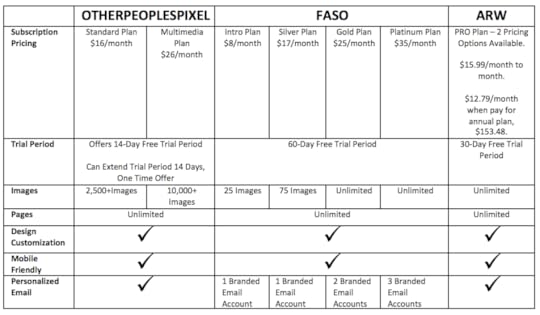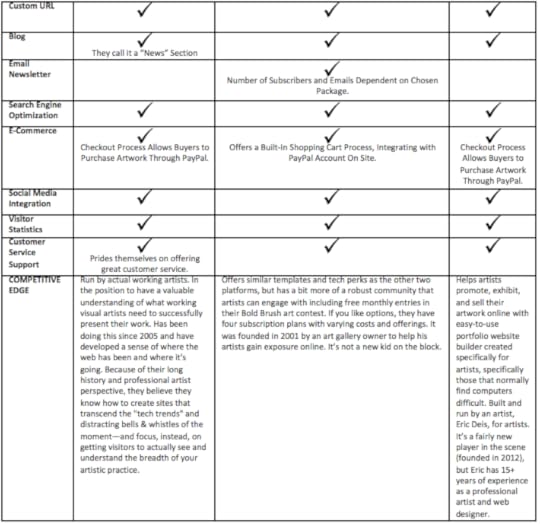Cory Huff's Blog: The Abundant Artist Goodreads blog, page 30
October 26, 2016
On Saying No
If I were going to name one reason people don’t see success, its because they fail to implement what they’re taught.
When I first started TAA, it took me a long time to get my head around this. We’ve had over 12,000 artists come through our courses.
There’s a whole world of people out there who never finish what they start. The entire online marketing course world revolves around the idea that students won’t implement what they’re taught, because if they did, they wouldn’t need those teachers any more.
The habits and daily actions that create success matter FAR MORE than what you know or who you know.
Most artists know they need to make art every day. But they don’t. If you do, you’re the exception. Trust me on this.
Most artists know they need to put in the time to learn to run their business. But they don’t. Then they sit around and complain about how no one appreciates them.
Here’s a secret to success: if you were to spend 1 hour per day marketing your art, after a month, you would be further along than 90% of artists. If you spent 2 hours per day, you would probably see significant income. If you spent 4 hours, I bet you could make $100,000 in your first year.
But people don’t. Because … well, there’s always a reason.
We recently ran a class and the most common reason people gave for not signing up for the class?
I haven’t finished my website yet.
That’s not the worst answer ever. It’s a requirement for the course to have a website before you take it. But we’ve had students finish a website in a week because they knew it was a requirement for joining the class.
I’m not judging you. There are lots of good reasons that people don’t finish things.
Sometimes a huge new commission comes in and you’re busy with paid work. That’s the best reason not to finish a course. Getting married, having a baby, a child getting sick, those are all legit reasons.
I run a small accountability program for a handful of our course alumni, and here’s what a typical 3 weeks looks like for one of our successful artists (slightly edited to remove identity):
Last Week:
Set up for ArtWalk.
Participated in two-day ArtWalk.
Took down ArtWalk display, packed up, put everything away.
Sent ArtWalk thank you notes to buyers and organizers.
Submitted images of older work for possible donation to new hospital.
Worked on second tutorial.
Worked on new series of art done with natural dyes.
Previous Week:
Finished first three pieces in new series. Photographed and put on website.
Researched how to use UV varnish on new work and applied varnish.
Worked on newsletter featuring three new Elemental pieces.
Retrieved consignment work from Museum and submitted invoice.
Previous Week:
Ironed all leaf print scarves and labeled for ArtWalk.
Curated jewelry to be shown at ArtWalk.
Curated paintings to be shown at ArtWalk.
Handed out the last of my ArtWalk cards.
Submitted work for ArtWalk Collector’s reception and delivered selected painting.
Attended ArtWalk Collector’s Reception.
Got everything ready for ArtWalk — painting labels, price signs, sales books, tables, tablecloths, etc.
What’s not present in these weeks? Excuses.
This artist is doing the work every single day. She’s doing the boring, repetitive computer work, as well as the anxiety inducing work of talking to people about her art. Live. In person.
So, all of the stuff that happens in life that can get in the way? Stuff like:
– chores & errands
– day jobs
– family obligations (I’m NOT saying you should ignore your family, but I have found quite a few people who haven’t even discussed their desire to have an art career with their families, so there’s never room made to make it happen)
Its all just noise. Its stuff that artists use to distract themselves from the unpleasant parts of being an artist.
Achieving your goals as an artist requires eliminating distractions and learning to say no.
For beginning artists, saying no might look like this:
– My sink is piled up with dirty dishes.
– I have a day job that doesn’t engage me, but it allows me to have mental energy for making art
– One night per week, I ignore my family and paint
– Every night after the kids go to bed, I work on my art business
For more experienced artists, saying no might look like this:
– I have a studio that I can use to escape from daily distractions
– I don’t do anything until I’ve painted for at least an hour that day
– I spent at least 50% of my time marketing my art, whether I want to do that or not
– Turning down paid opportunities that distract from bigger paying opportunities
So, what do you need to say no to right now in order to move your art career forward?
The post On Saying No appeared first on Online Marketing for Artists.
October 14, 2016
Introducing TAA Agency Services
Over the last year, I’ve had a number of conversations with artists like you who are dedicated to their craft and have seen some financial success from their efforts.
Over and over again I’ve heard that one of the biggest struggles after you start to see that initial success is managing the sheer amount of work that goes into running an art business. Between making the art, corresponding with galleries and collectors, framing, shipping and trying to have a life outside of work, there’s barely any time at all to pay attention to your own marketing efforts, so that tends to get dropped.
And when the marketing efforts get dropped, the sales go away. Boom and bust cycles are common in the art business because of this pattern.
Or sometimes you’re making art all of the time, but the process becomes less fulfilling because you’re spending all of your time fulfilling commissions and not exploring your own ideas.
However that breaks down for you, the point is that at some point there just isn’t enough time, and either your bank account or your art suffers.
What I’ve heard from many artists like you is that you’d like to have someone to do some of that stuff for you – especially the boring stuff like email newsletters, social media management, and writing blog posts.
So, here at TAA, we’ve decided to finally step beyond our purely educational business, and begin partnering with a limited number of artists to take on managing your marketing.
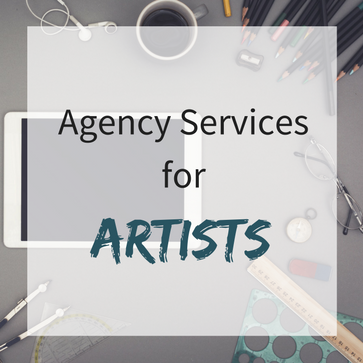
TAA Agency Services
We have designed some basic marketing packages that include:
– Monthly one on one strategy sessions to discuss long-term direction in your business
– Public Relations outreach to get coverage and placement in media relevant to your art
– Weekly social media management to grow your fan & collector base
– Ghost writing for your blog to grow traffic to your website and your art pages
– Ecommerce management for your website to make sure you have good images and copy for your art
I, and the TAA team, have years of experience doing exactly this for many other small businesses. In addition, we have been working behind the scenes with a number of highly prolific and successful artists to test some of what we’re doing, and we feel really excited to start offering this as a service.
Book a Consultation Call
If you are interested in booking a session to talk about how TAA Agency Services can help you earn more money from your art, as well as make your life easier, click here to book a totally free consultation call.
PLEASE NOTE: I’m not going to try to hard sell you. I only want to work with artists who are excited about hiring someone to manage their online marketing, who have a budget to do it, and are looking for a consultative partner for the long term.
Prices for TAA Agency Services will range from $300 per month for simple things like social media strategy and management to $2000+ per month for the full suite of marketing services.
If this is interesting to you, click here to book a consultation call, and we can discuss the details of how it all works.
http://theabundantartist.com/scheduling
If this doesn’t sound like a good fit, no problem. We are looking just for those artists who are ready for this kind of step.
Thanks for taking the time to read.
Sincerely,
Cory Huff
P.S. We really are only taking a small number of artists on as TAA Agency Services clients. We’ve been testing on a limited basis, but now we are looking to see how this kind of business will grow and whether we can keep up with the demand. Our initial group will likely not be more than 5 artists, at least until we feel like we have a good handle on how to manage everyone. So if you’re intrigued, please click to schedule a call.
The post Introducing TAA Agency Services appeared first on Online Marketing for Artists.
October 4, 2016
Win a 1:1 Coaching Scholarship from TAA
Every time we run our flagship course, How to Sell Your Art Online, we offer 10 slots for one on one coaching. This includes everything from the course, along with 90 minutes of one on one time to make sure you are getting the absolute most out of your art business.

Based on the generosity of a previous TAA student who is doing quite well because of the course, we are giving away one of those spots as a scholarship. That’s a $750 scholarship.
Here’s what you can do to win.
Create a short video or visually interesting image explaining why you deserve this opportunity, and what your vision is for how your art will impact the world. (please note: no sob stories – I’m looking for an artist that is going to be fun to work with, who has a vision for their future, and just needs some help to get there).
Share that content on social media (Facebook or Instagram) and tag The Abundant Artist in your post so that we see it. We will pick a winner Friday morning, so you don’t have a ton of time – if you’d like the scholarship, jump on it now!
*legal stuff: one entry per person, no purchase necessary to win, and the winner is picked at our sole discretion based on the above criteria.
The post Win a 1:1 Coaching Scholarship from TAA appeared first on Online Marketing for Artists.
September 30, 2016
My Latest Q&A, From Facebook
Earlier this week, I encouraged everyone to head on over to our Facebook page to let me know what their primary questions are about selling art online.
The very best set of questions came from the artist Ruth Collis.
I would guess that many of these questions are your questions too. Let me see if I can break it down for you, question by question.
###########
Some questions going through my mind at the moment…
***Can we attract wealthy collectors to buy online and not need a gallery to where they can see even 3-dimensional art? Like if a video showed all the angles.
Yes. It happens, but less frequently at higher price points (which is true offline as well, btw). The truth is that most art sold online is lower priced (probably below $10,000), but there are certainly exceptions. Unfortunately, the art world is notoriously secretive about their sales, but I personally know a handful of artists who have sold pieces for prices ranging from $10,000 – $100,000, all online, without having seen the piece in person before.
Normally, these kind of sales don’t just happen out of the blue. The buyer usually has a prior relationship with the artist, perhaps because they purchased from the artist before and really trust the artist’s work. Alternately, the buyer might trust in someone else’s opinion, like the gallery owner or a collector friend.
Either way, big ticket art sales happen by building a relationship with your collector. The video idea is a good one, but you can’t just use video. You also have to do things that build relationships with your collectors, and that takes time.
***How do you find higher end art collectors that would appreciate quality?
There’s not a magic trick to it. Essentially, it comes down to showing your art to as many of the right people as possible, and having conversations with as many folks as possible.
Identifying your target audience is a bit of a guessing game when you’re getting started. You can do some research by looking at existing artist websites with art similar to your art, and that will give you an idea of the kind of language that they use.
Beyond that, you can find Facebook groups around the kind of art you make, as well as tangential interest.
But the best thing you can do is start having conversations with people, and ask them questions about their reactions to your art.
Here is a blog post about finding your ideal collector.
We also talk about this quite extensively in our How to Sell Your Art Online course.
***Is there an automated process to send collectors through a funnel (like email series, and what if a painting sells, then you have to update your email series to send the next wave to a painting), or does it work best to post on social media and do the same work for each prospect?
You can certainly automate a great deal of your marketing. Sending all new email subscribers through a series of emails that let them get to know more about your history as an artist, and an overview of how to understand or think about your art, is an ideal scenario.
In our How to Sell Your Art Online course, we talk about this extensively. Three of the lessons are on email marketing, and we actually give an entire example series that you can adapt for your own audience.
***Could we ideally hire a person to do our selling/answering phones, to keep us focused on art output?
Of course. First of all, I should say that the person who answers the phone is not necessarily the same as the person who does the selling. If you’re going to hire someone to do the selling they need to be really good at selling. Really good sales people are usually terrible administrators.
For sales, you have a couple of options.
You can partner with an art dealer, or you can hire and train someone.
If you partner with a good art dealer they usually have existing connections that will help you sell quite well. Look for a dealer who has sold art similar to yours before. Unfortunately good art dealers are usually quite busy, and the only way to find one is by asking people in your network and building relationships with the ones who like your art.
Artist agents also exist, but they’re far less common. These are usually companies who will handle marketing for you for a fee. The Abundant Artist is testing some of the services out with a handful of artists right now. If you would like to know more about that you can contact us.
The other option is to hire a young person who is good at talking to people, and is enthusiastic about your art. You’ll need to pay them hourly until they get trained up, but then you might be able to pay them on commission when they get good at it.
All of that said, you still need to understand the basics of successful selling yourself, so that you know whether your dealer or new trainee is doing the right things for you.
***How does one find the source for getting their art in hotels (in bulk amounts) before the building is even built?
You’re looking for an art director or a commercial art dealer. Architects, and contractors, hire art directors for new construction projects. These art directors source artists from their existing contacts. I would recommend googling art directors in your local city and begin reaching out to them with a link to your portfolio.
***When a piece does sell, what do you do with the web page to still make it profitable? Put AdSense on it? But then you are taking the viewer away from that which you worked hard with SEO to get them there. What if the traffic were already your list members somehow… then what is a good way to monetize those pages of art that do sell? The pages are taking up space and you’ve referred to them over the web and in books, reports, etc and wouldn’t want to take them down really.
Sell prints or other reproductions! If you’ve already done the work of marketing a particular page, and its receiving significant traffic, add an option for people to buy prints. You can offer prints on demand through a variety of service. Here’s a link to our Print on Demand Guide.
***Is there a way to build a following faster than doing joint ventures that are not often in your particular style?
You can:
– pay for ads
– partner with charities
– partner with public work projects with your local government
– ask someone with a large audience to talk about your art
– court the art press, especially locally
(we talk about how to do these last two in our How to Sell Your Art Online course quite a extensively)
Thank you, Cory, for all this and making the next day visible too, to get a big picture idea, and to get ahead when my schedule permits.
############
If you have additional questions about selling art online, click here to ask. We will be doing these Q&A’s until October 8.
In the mean while, we would love to have you in our course, How to Sell Your Art Online.
The post My Latest Q&A, From Facebook appeared first on Online Marketing for Artists.
September 16, 2016
The #AbundantArtShow 8 Day Challenge Results
A couple of months ago, I asked the members of our student Facebook group what kind of challenges they would like to see.
One of the events that came out of it was the 8 Day #AbundantArtShow challenge.
We had some very impressive results from some of the 500+ artists who participated in the challenge.
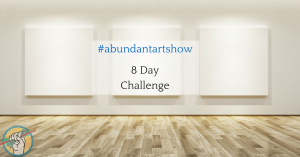
What is the Challenge?
Its very simple: every day for 8 days, we send you one email with one action item. You do that action item, and art sales follow.
What are the actions? We are going to ask you to:
publicly commit to the challenge
take pictures of your art
share your art on social media and/or email
look through the art that is being shared and find your favorites and share them
ask people to buy your art
That’s it. It’s that simple.
I also jumped on a Facebook Live video broadcast each day to encourage the artists who were participating, call out victories, and answer questions.
But simple is deceptive. Simple is powerful.
#AbundantArtShow Challenge Results
25 artists sold a piece of art in the first week of the challenge. I’d call that a pretty rousing success! Way to go everyone! Here’s some quotes from artists who participated.
“I had a sale yesterday, Cory – one of my small paintings in the Daily Paintworks auction. Yippee! Thank you for this week – it’s been fun and I saw, and shared, some great art.” – Susan Woodward
“I sold 13 original art cards, not prints, at a business networking breakfast so that’s 14…original pieces of art.” – Rosie Kaplan
“This challenge has been eye opening. It really does show the work that goes into selling your work. These are simple steps that if repeated can yield results. Gives me courage.” – Beth Brown
“Thanks so much Corey! Yes i signed up a client this week for $1000 commission.” Awesome. – Christopher Neilson
“Thanks for the challenge. It was fun and interesting. And I sold a painting this afternoon. It sold to a friend, but was a direct result of the challenge.” – Ethel Hills
“I also booked a solo show for December.” – Kadira Jennings
“I actually sold two pieces using Facebook and an email promotion.” – Marianne Goodell.
“I landed one print sale (a family member but hey!), a few extra followers, and a possible commission! Thanks!” – Elaine
“Barely 3 hours after i set up…i got a message by an editor of an art magazine focusing on female artists asking me to be featured their next issue!!!!
“I can’t thank you enough! This challenge was the kick in the butt i needed!!” – Ava
“I sold a painting on instagram and got new followers on instagram. I also sold a painting off my wall at my house which is covered with my art. I think it’s because of the course and just getting in the groove that is changing my consciousness about selling and the need to sell that is doing it, so Thanks, Cory. It’s a mindset isn’t it?” – Sheryl Southwick
We’re Doing It Again
Starting this Monday, September 19, we’re doing the challenge again. You can participate by clicking here. Don’t think about it too much. Just join us and do something fun and challenging!
By the way – if you’ve already done the challenge, you’re more than welcome to do it again!
And yes, its free!
The post The #AbundantArtShow 8 Day Challenge Results appeared first on Online Marketing for Artists.
August 31, 2016
All the Wrong Questions About Selling Art on Facebook (plus a Free Webinar)
Nearly every single artist is asking the wrong questions about selling art on Facebook.
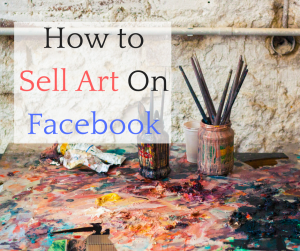
Two weeks ago I started asking artists what their biggest questions are about selling art on Facebook. Some examples of the kinds of questions that I’ve seen:
Is it okay if I sell my art from my personal page instead of my business page?
Should I just use Instagram instead, since their algorithm doesn’t hide me from my followers?
How do I see the full list of people who Like my page?
These questions fundamentally ignore one important thing every artist needs to understand: selling art is a business.
If selling art is a business, then:
no, you shouldn’t be selling art from your personal profile (its against FB’s terms anyway and you’re going to get your account shut down)
Facebook owns Instagram and pretty soon Instagram will be pay to play too (you did know that Facebook is already pay to play, right?)
Who cares if you see the full list of people? What are you going to do? Message all of them and ask them to make a purchase? That’s an enormous waste of time.
***In other words***
Learning to sell your art means you need to learn how to do hard things.
At the very least, you need to start understanding the fundamentals of online selling: attention, clicks, and landing pages.
In addition, selling on Facebook in 2016 means understanding these things:
– the algorithm
– the retargeting pixel
– the ad platform
I’ve been shouting it from the roof tops for two years: Facebook is an advertising platform. If you are depending on your followers seeing your posts without any paid boosts, good luck getting some sales from the 5% of your audience that sees your posts.
You must learn to play by Facebook’s rules if you want to succeed there. I’ve seen lots of artists do it. When I went looking for case studies, I found dozens of artist who get it, selling their art on Facebook as their primary sales source.
Soooooooo……
Let’s talk about what to do about it.
Free Webinar: Selling Art on Facebook
This week I took on 10 artists, putting them into a small group to personally manage how they implement their Facebook ads.
This webinar will show you what I’m doing with them, as well as what has worked for other artists.
On Thursday, September 8 at 10 AM Pacific / 1 PM Eastern time, I’ll be holding a webinar to talk about what it takes to succeed on Facebook now, in late 2016.
We will cover:
Facebook basics (business pages, and why you can’t depend on the personal profile for long-term growth)
The infamous Facebook algorithm and why it buries your posts – and what to do about it
How you can effectively use paid ads to promote your art
What retargeting is and how to do it right
If you want to join us, click here:

This webinar is going to be epic – I won’t be holding anything back. I’ll show you the stuff I’ve been working on with these other artists, as well as what some of the most advanced marketers are doing on FB.
YES, there will be a recording, but you have to register to see it.
The post All the Wrong Questions About Selling Art on Facebook (plus a Free Webinar) appeared first on Online Marketing for Artists.
August 17, 2016
What Makes a Great Art Work in Progress Post?
Artists are always asking me what they should share on social media. I took a few minutes and put together some great work in progress images and videos from Instagram and Facebook.
These are all working artists like you, who give a little bit of an insight and context to their art, and it helps them sell more art. I hope you enjoy them.
Example WIP posts:
Great Facebook Posts:
Michelle Leivan’s studies & progress album on Facebook. LINK
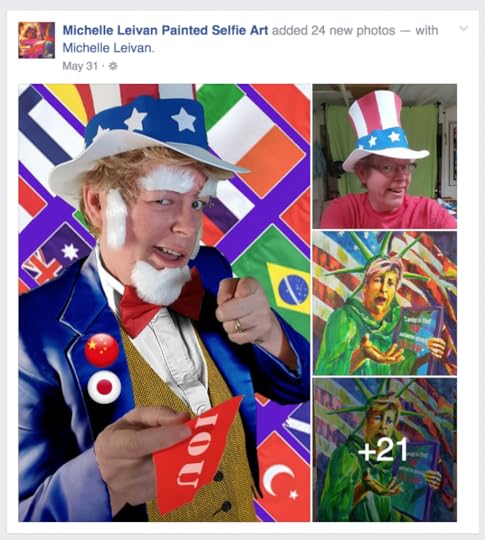
Jeffrey Dean’s sculptures in progress. LINK
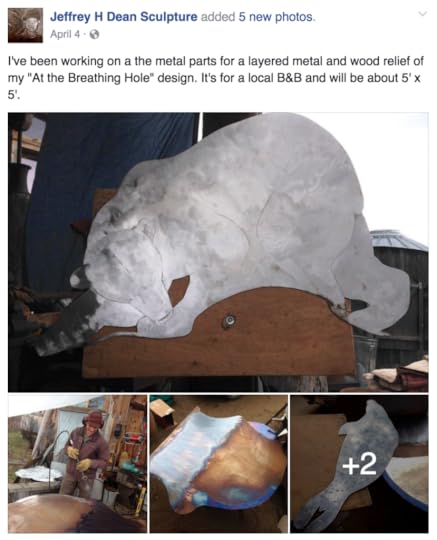
Here’s a great time lapse video by Meghan:
The post What Makes a Great Art Work in Progress Post? appeared first on Online Marketing for Artists.
August 12, 2016
ArtStoreFronts.com Review: A Done for You Print on Demand Service
In our continued quest to test most of the major website platforms and figure out the best options for you, dear artists, we’ve taken some time to give ArtStoreFronts.com* a try.
Disclosure: ASF pays me to be a community liaison for them in their forums.
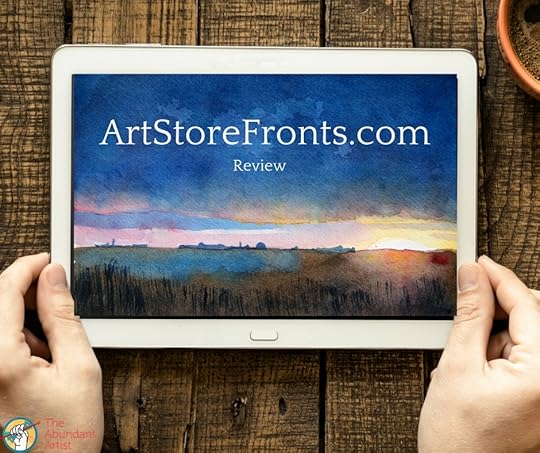
ArtStoreFronts.com = A Done For You Print on Demand Service
A website service similar to FASO, Shopify or Squarespace, ArtStoreFronts.com (ASF) offers websites for artists who want to sell prints, giving you a Print on Demand (POD) business for just your art, alongside a store where you can also sell original art.
We’ve covered the POD business a couple of times before here on the TAA blog. See our Ultimate Guide to the Print on Demand Business.
Other POD companies act as marketplaces where thousands of artists sell their art. These companies also act as gatekeepers between the artist and the buyer. The customer’s contact info stays with the company, and the artist is unable to market to that person again later.
ASF solves this problem by connecting the website that provide for you with a printer who will print, package and ship to the buyer. Since the transaction happens on your website, the buyer’s info is yours and you build your mailing list when you make sales. ASF sites do all of the things you need them to do – ecommerce, a blog, secure transactions, and more. They also allow you to add tracking pixels for marketing on Facebook and other advertising platforms.
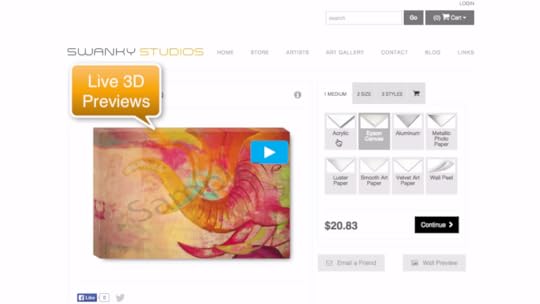
What Artists Are Saying
ASF has a host of testimonials and positive reviews on their website. I communicated with one of those artists, William K. Stidham, via email and he told me:
…the fact it ties directly into Skyline Art Printing for fulfillment makes my life easier. They also came up with a great teaser at the front of my website offering the end user a 20% discount on their purchase. It has more than paid for itself on a monthly basis.
All in all, I’m super happy with Art Storefronts! They have completely streamlined my system, and dramatically improved the way I sell my art online, and fulfill my art for my customers!
I spoke to two artists who were very frustrated by their ASF experience. One artist, a successful wildlife oil painter, told me this:
“My Art Storefronts experience continues to be a nightmare for me so I’ve begun the transition over to Shopify’s professional plan with abandoned cart recovery.
My list of negative experiences with Art Storefronts is pretty large but to sum it up in short I feel I’ve lost control of my business (my authorized print studio has more control than I do), I receive weekly emails (3 yesterday alone) from people trying to buy but are too confused by the print design interface on the product pages… With Shopify I can continue offering various price points with drop shipping from my reliable print studio, and build the site way it should be.”
When I asked ASF about this quote, they said that ASF had multiple accounts that had millions of dollars in sales.
William Stidham also mentioned some frustrations with the point of sale system, “I’ve suffered through some growing pains…To their credit, they have addressed many of the initial limitations… Especially their payment processing.”
Not for Beginners
ASF carries a relatively steep price tag for a template website service. Their setup cost is $1999, and their monthly fee is $29 – $59 per month (a discount is available if you pay annually). ASF says that this up front fee is because they schedule an initial onboarding call with a member of their staff to make sure you get your site up and running successfully.
In addition to the fee, the website can be relatively time-intensive to set up. Because ASF offers many variations of sizing and substrates for each of your paintings, setting up each piece of art can take some time. If you aren’t used to complex internet and software tools, ASF might cause you some frustration.
Because of this heavy up-front investment, we recommend that if you are just getting started in your art career and don’t have a strong business background with a clear path to recovering that investment, we recommend you start with something simpler. See our guide to picking an artist website service.
The Success Plan
With all of that said, ASF has an impressive Success Plan. It’s a step-by-step guide to selling art online with their platform. ASF’s team includes some pretty savvy marketers. I’ve had a few conversations with them, and I respect their knowledge. At the very least, you should read their blog, because its both hilarious and really helpful – a rare combination indeed.
Its Up to You
At the end of the day, ArtStoreFronts.com* is like any other artist website platform – its just a tool. They provide a website that works, albeit with a fair amount of complexity. While we don’t recommend ASF for beginners, we think that its a solid option for artists who have a strong audience and business acumen.
*indicates affiliate link
The post ArtStoreFronts.com Review: A Done for You Print on Demand Service appeared first on Online Marketing for Artists.
August 9, 2016
How to Pick the Right Artist Website Service
Probably one-quarter of the questions I get here at TAA boil down to this:
How do I pick the right artist website?
In this blog post, I’m going to break down some of the primary considerations for building an artist website.
Here, you can watch me talk through the logic in this post.
Artist Website Prerequisites
There are a few things you need to consider before you ever start evaluating services, and way before you start building anything.
Make an Artist Website Feature Checklist
Make a list of all of the features your website needs to have. If you aren’t sure, download our checklist by clicking here (no opt-in required).
What Kind of Art Business Are You In?
Selling Originals & Prints directly to collectors – in this kind of business, ecommerce becomes absolutely required. Most people are used to buying things online at this point. Make it as easy for them as possible. Check out our blog post on accepting payments online.
Commissions – if you are taking commissions on a regular basis, you know what a challenge it can be to walk something through the process. Get a reference picture from them. Get a due date. Collect payment up front. Sign contracts. All of this can be done through your website with an intake form. Make sure your website provider has a form builder that will collect the info that you need.
Selling through galleries – the only time, in my opinion, that an artist should not have ecommerce is if the artist is represented by a gallery that doesn’t want them to have it – and here’s the important part – that gallery is bringing in significant revenue for the artist. Don’t let a gallery dictate your business, especially if they aren’t doing anything for you.
3 Mistakes Most Artists Make
Making sales too hard. This goes back to ecommerce. Too many artists require things like emailing them for pricing, which means there’s delays where the collector’s enthusiasm cools. When you think you’re ready to launch your website, ask 5 friends to pretend they’re going to make a purchase and get their feedback.
Poor design. Get rid of clutter. Design shouldn’t distract from your art. The primary graphics should be high-quality pictures of your work. Do your research and find some artist websites that are exciting to you, and see which elements of their designs you can emulate.
Context & writing. Basic elements like sizing and medium are an absolute minimum. Giving a sentence or two about the piece, describing it and and describing a story behind the piece will help a lot. Blog posts and social media posts will also help a lot. We’ve written about this extensively here, here, and here.
Technical Skills
Let’s talk about technical skills for a moment. You absolutely do not need to know how to code to build a website. It’s helpful to know a little CSS and HTML, but if that alphabet soup scares you, no worries.
If you are the type of person who likes to DIY, or you just like having the ultimate control, then you might consider WordPress. We’ve written extensively about building websites with WordPress, a free software that allows you to build your own site. There are lots of free templates that will help you get started.
How to Build An Artist Website in 10 Minutes – with free themes like the one outlined here, you can get a site up and running in very little time. But you have to be comfortable with doing a lot of button pushing, as well as a lot of trial and error. For non-tech savvy artists, I estimate 20 – 40 hours to get a website that is usable.
Divi Theme builder review and tutorial – there are paid themes for WordPress that make the building process easier. Many of those themes have great support and tutorials that make the process easier, cutting way down on the amount of time it takes to build a site. One of my favorites is Divi, for reasons I outline in the review.
No technical skills at all? Just don’t have the time? There are dozens of website building services. TAA has done reviews of many of them.
Finally – Artist Website Services
Shopify vs. Squarespace – Shopify is, as of this writing, a clear leader in the space. They have thousands of third-party integrations, making it possible to do almost anything with their sites. Combine that with phone support, you get some solid options there. We also like Squarespace for artists who want something simpler.
Fine art Studios Online or FASO (in-depth review coming soon, see below). FASO is built specifically for artists, and they have awesome support as well. They have done a good job of updating their theme options for current mobile standards. We like what they’ve got going on.
Weebly & Wix (coming soon)
ArtStoreFronts.com (coming soon)
Other People’s Pixels and other artist-specific builders. There are dozens of providers. We put this chart together.
Hopefully this helps you get some clarity on what you need to do to get your artist website up and running – or increase your sales.
Check out our course – Artist Websites That Sell
 Click here to learn more about our course that will help you build your first site or make your existing site sell even more art.
Click here to learn more about our course that will help you build your first site or make your existing site sell even more art.
The post How to Pick the Right Artist Website Service appeared first on Online Marketing for Artists.
July 26, 2016
Willa Koerner: Kickstarter’s Head of Curation
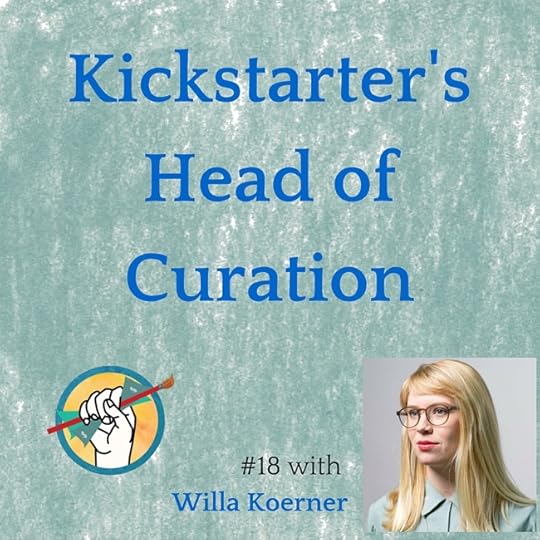
In this episode, we cover:
1:15 – what the field of curation includes and how Willa Koerner got started in that world. Figuring out how to tell the story of opaque artists like Rothko and help people identify with that work.
6:00 – how internet culture is influencing the art world, and the very real challenge that far too many artists are ignoring the way that the internet is influencing the real world. There is art made with code or that can only be experienced online, and is just as valid as art in a physical space.
Some example artists:
11:30 – the rising potential and opportunity for creating art in virtual and augmented reality.
Black Out’s Kickstarter campaign and Blackout Virtual Reality homepage.
17:10 – how Willa went from working at the MoMA to working at Kickstarter, and why she did it. Willa’s job is pretty incredible. She and her team are tasked with being aware of the truly unique and original ideas that people have so that Kickstarter can promote innovative ideas.
22:30 – how Kickstarter handles the filtering of the hundreds of projects that are seeking crowdfunding. They are not just looking at what’s on the site, but also out in the world talking to people working on their dream projects.
26:00 – Willa’s advice on how to get your work in front of more people. “Think about how I am communicating my work” and “if I were going to give the elevator pitch for my work, what would that be?”
32:00 – how to connect with a curator like Willa to help promote your work. Learning to network effectively.
The post Willa Koerner: Kickstarter’s Head of Curation appeared first on Online Marketing for Artists.
The Abundant Artist Goodreads blog
- Cory Huff's profile
- 31 followers





